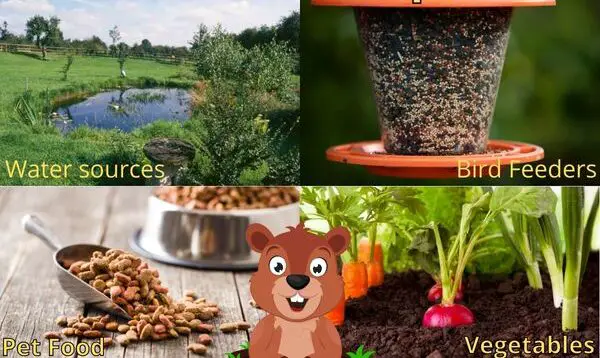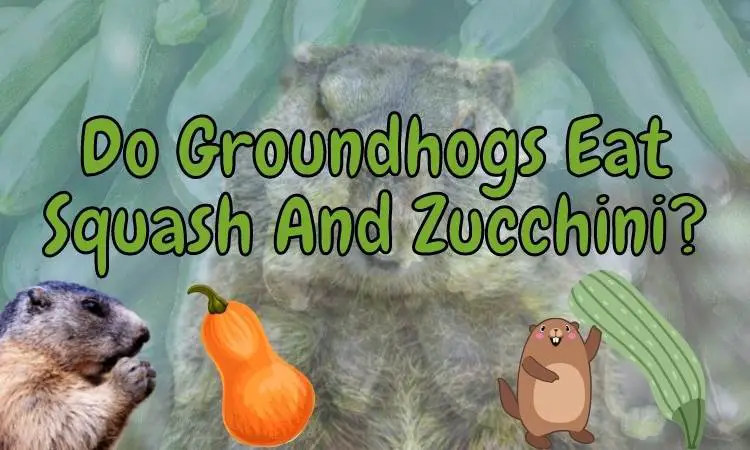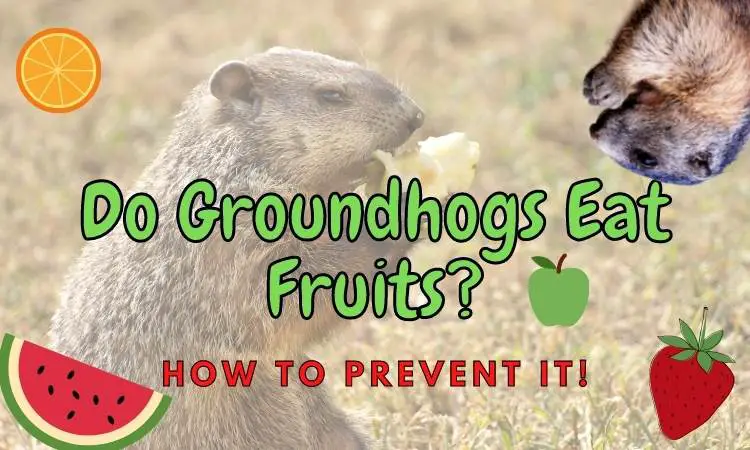One of the most prevalent types of ground-dwelling rodents is the groundhog. It is common to find them outdoors and in places like vegetable gardens and parks, which are generally related to the soft soil where they are found.
Groundhogs will be attracted to various flowers, vegetables, trees, and other plants in your yard (including your lawn!), and they do prefer backyards with a water source such as a pond. They will also be attracted to bird feeders and other pet food or accessible garbage.
Groundhogs can thrive on many plants, including trees, shrubs, vegetables, flowers, and grasses. They thrive by eating the plant’s stems and roots. The best bait for groundhogs includes alfalfa or vegetable stems and roots.
Most people have had to deal with groundhogs at some point. If not, it is quite probable that you will. It is also possible that their waste products will disperse across their environment as they move through the ground.
Groundhogs are undoubtedly a big problem for both farmers and homeowners. To keep groundhogs from returning to your garden or yard, the first thing you should do is to identify what attracts them.
I will also show you my favorite ways to deter them at the end of this article (but hopefully you won’t need that yet!).
Contents
What are Groundhogs Attracted To?
As you have probably already read on my site, groundhogs are mostly vegetarian but will eat some insects.

They will also love whatever food items you put out like the seeds of bird feeders and pet food.
This means that your vegetable garden is a preferred hideout for them because of the variety of vegetables, pet food, and plants available. However, although groundhogs prefer root vegetables, they do mostly eat more easily accessible foods such as grass!
Considering that groundhogs are mostly nocturnal, they like to spend most of their daytime underground and will come out to forage at night.
As they do not see well, they rely heavily on their smell to find food. So strongly smelling food items attract them more than more subtle ones!
Also, if you have chickens or other animals, they will smell them from afar and associate them with livable conditions and food.
And while groundhogs do not eat larger animals, they do eat their feed and also the insects and worms they might attract!
A garden pond or a pool is also a plus for groundhogs, as it means better access to fresh drinking water. And they might even go for a swim!
A watering sprinkler system, on the other hand, will often deter groundhogs as they do not like being out in the rain and it may collapse their tunnels.
Groundhogs love the roots and stems of carrots and potatoes and those of other vegetables like shrubs, radishes, grass, and even flowers. Aside from that, they also like eating a different variety of insects.
The more foliage you have in your garden, the greater the likelihood that groundhogs will smell it and make your yard their home. Groundhogs continually look for new locations to establish a home base in their quest for food.
Grazing the lawn with other clover and grass is not uncommon for them and they will easily smell and be attracted to most of your garden flowers.
However, they prefer to consume the tubers and roots of acorn seeds and plants.
What Smell Attracts Groundhogs?
The scent of food is one of the strongest smells groundhogs use to find their way around. A hungry groundhog will walk straight toward the smell of juicy vegetables, most large flowering plants, and most seeds or nuts.
Groundhogs are mainly attracted by the smell of food. Their preferred items to eat include things like various flowers, vegetables, bulbs, tubers, delicate stalks, bird seeds, pet food, leaves, and grassroots. Beyond that, they also like to ingest the roots of trees.

In line with that, the desired groundhog smell includes the scents produced by rotten fruits. However, this type of pest may completely ignore a trap or bait if it smells like human sweat. On the other hand, you can always use grass and rotten fruits as groundhog bait.
But you may need patience, as groundhogs can stay in their tunnels for months due to their ability to store food for later!
But groundhogs are also attracted by the smell of mates, which they can smell even when underground!
The males dig their tunnels to cover a large area so that their chance of digging into the tunnel of a female groundhog is maximized.
As soon as they enter a tunnel of the opposite gender, they can smell it and will search for the individual to mate.
What smells do groundhogs hate?
Moles dislike the smell of garlic, marigold, basil, lavender and mint. Some people crush elderberry sprigs and insert them into groundhog. Others swear by mothballs, coffee grounds or castor oil with cayenne pepper mixed in.
Mint, as well as other herbs, are too strong-smelling for the sensitive nose of most groundhogs.
The classical trick to scare away groundhogs from your yard is to insert any of these smelling objects or plants into the opening of the groundhog tunnels.
The problem with anything inserted into a groundhog tunnel is that most tunnels have multiple, often hidden, exits. They usually live in large chambers that are farther underground than the surface tunnels.
They may also hide elsewhere, such as in a large hollow tree, if their tunnels are not accessible anymore.

Their main tunnels can be 8 to 23 inches below the ground surface, meaning that it’s really tough to get any scent deterrent into a tunnel where it will really be a deterrent. Trying to smoke them out is also problematic, as a large number of surface tunnels disperses the smoke and it seeps up through the soil as well.
What Foods Attract Groundhogs?
When you think of rodents, groundhogs aren’t the first animals to come to mind. In fact, most people have never even seen a groundhog, let alone interacted with one. But while groundhogs may not be the most common rodents around, they are certainly one of the most common species of pest rodents.
As with other rodents, the diet of groundhogs is a broad one – including everything from flowers, to roots, vegetables, and insects! In any of these are easily accessible in your yard, they will attract groundhogs.
Groundhogs consume a wide variety of vegetation with no particular preference. Crops, flowers, and plants have been damaged by them. Groundhog’s diets are affected by the availability of food sources. They may eat a wide variety of plants depending on where they live.
I have already written about the diet of groundhogs, so you can read more in my recent posts:

They consume plants that are part of the yearly flora-eating cycle. Depending on the season, a groundhog’s diet may change. Foods eaten by groundhogs include a broad range of things, but these are the most common:
- Tree roots and barks
- Flowering plants
- Seeds
- Grasses
- Onions and leeks.
- Sweet potatoes
- Bulbs
- Fleshy roots of trees and plants
- Succulent vegetation
- Pet foods
- Some meat, insects and worms
- Some human foods
- Dandelions and alfalfa
- Numerous other garden vegetables.
If you are more interested in the diet of groundhogs, check out my other posts on that subject here on the site!
What Plants Attract Groundhogs?
For the most part, groundhogs eat grasses and forbs as their primary source of nutrition. Forbs are a genus of large-leaved plants with herbaceous stems native to North America.
Those include hyssop, watercress, goldenrods, asters, and sunflowers. However, only a few species of shrubs may be found among the flowering forbs.
Vegetables, such as cabbage, potatoes, and carrots, are among their favorite foods.
However, they also consume a lot of fruits and seeds, and if a bird feeder is present in your yard, they will eat what falls to the ground!

However, because these items are not too abundant in all yards, groundhog’s diets were discovered to be 64 percent grass-based, as concluded by the Colorado scientists. These tiny rodents like eating dandelion and clover throughout the summer and spring.
Aside from that, researchers in Nebraska tracked the feeding patterns of pocket groundhogs over three years as part of their study.
These people concluded that more than half of the groundhog’s diet was made up of grasses available in the area they live in – so having a lawn is a huge attraction for a groundhog!
In the early sprint and late summer, these groundhogs were shown to eat a variety of roots or anything available to them, but grasses are simply more abundant.
How to Keep Groundhogs Out of Your Yard
There are several methods for keeping groundhogs away from your backyard and I have written more extensively about them here.

I have listed them in the order of which ones I find are the best solution and what I see recommended by friends and people around the internet. The ultrasonic devices seem to be the most popular!
1. Ultrasonic Sound Emitters
My absolute favorite invention to keep pests away from my backyard are these cool solar-powered ultrasonic sound emitters that you can buy right off Amazon!
Groundhogs and groundhogs, as well as other animals that may invade your garden, tend to have very good hearing so they will be bothered by ultrasonic noise that we humans cannot hear!
They send out loud or consistent noises (that only they can hear) that will scare them away or at least shorten their visits significantly!
In my experience, they really work, and the solar panels on top save you the time and money of changing batteries all the time.
2. Fencing
Fencing is the best way to keep groundhogs away from vegetables. Groundhog-proof fencing is typically made out of poly wire, plastic mesh, or heavy-gauge wire netting.
You can build a simple fence to surround an entire garden or yard, or you can create individual small enclosures for each vegetable plant in the garden.
3. Groundhog Traps
Use groundhog traps to catch and kill groundhogs on the ground before they can eat your vegetables.
There are several types of simple traps that you can use, but most work best if you set them after the groundhogs have already started chewing on your plants.
I prefer those that catch them alive, so you can drive them far away and set them free.
4. Water and Fertilizer System
If you have drip irrigation or a sprinkler system in your yard, then you can trick groundhogs into thinking that heavy rain is coming and that the entire area is flooded because of all the moisture.
This will discourage groundhogs from digging up your veggies because they prefer to stay dry when possible and because they cannot breathe in flooded tunnels!
If you don’t have a drip irrigation system then you can water your vegetable garden a bit more than usual when groundhogs are around. This will keep the groundhogs away, just like flooding the entire yard would.
5. Motion-activated sprinklers
Like most animals, groundhogs hate surprises, and they will run away if suddenly sprayed with water. I like this solution because it is humane, simple, effective, and does not require much time to set up and there are many models to choose from.
For more inspiration on how to keep groundhogs out of your yard, see my latest post for a full and updated list of the most effective means of keeping groundhogs and groundhogs out of your yard.
Conclusion
In conclusion, groundhogs are attracted to yards with soft soil, a variety of plants, and access to water. They are mostly nocturnal and rely heavily on their sense of smell to find food.
Groundhogs will eat a wide variety of plants, including vegetables, flowers, grasses, and roots and bark of trees. To keep groundhogs from returning to your yard, you should identify what attracts them and reduce those attractants or use my recommended methods to deter them.













